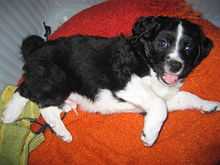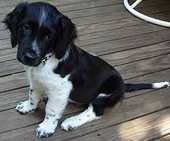Stabyhoun
 | ||||||||||||||||
| A Stabyhoun | ||||||||||||||||
| Other names | Frisian Pointer Frisian Pointing Dog Stabij Beike | |||||||||||||||
|---|---|---|---|---|---|---|---|---|---|---|---|---|---|---|---|---|
| Nicknames | Staby | |||||||||||||||
| Country of origin | The Netherlands | |||||||||||||||
| ||||||||||||||||
| ||||||||||||||||
| Dog (Canis lupus familiaris) | ||||||||||||||||
The Stabyhoun or Stabij is a rare dog breed that just like the Wetterhoun originates from Friesland, a province in the North of the Netherlands. The first part of the name is probably from the Dutch: "sta me bij" (stand by me). The last part is simply Frisian, meaning dog, which is pronounced "hoon". There are only approximately 3507 Stabyhouns in existence today.
Description
Appearance


Coat
Most Stabyhouns have a black and white colored coat. Brown and white Stabyhouns are less common, but may be seen in the Netherlands, while the orange and white coated Stabyhouns are becoming increasingly rare.[1] Spotting and/or roan in the white are acceptable, but tricolor is considered a fault. Males are 53 cm (21 in) and females are 50 cm (20 in), measured at the withers. The ideal weight of a Stabyhoun is 45 lb (20 kg) for a female and 50–55 lb (23–25 kg) for a male.
Head
The head should show more length than width, with the skull and foreface equally long. The hair on the head is short. The skull should be slightly domed, but not narrow, and may never give the impression of being wide. The head is carried low on a strong, slightly arched neck. The stop is only slightly indicated. The foreface is powerful, tapering gently toward the nose without giving the appearance of a point. The bridge is straight and the muzzle is broad with a nose that is well developed and has wide nostrils. Lips are tight and cover the teeth, which are strong and have a scissor bite. The neck should be free of throatiness or dewlap. The expression of the face should always be gentle and intelligent.
The ears are set fairly low, medium in size, and are strongly developed. The ears project from the head, and are moderately long and shaped like a mason's trowel. Feathering on the ears is typical, with hair growing longer at the base of the ear and steadily decreasing in length. The bottom-most third of the ear is covered with short hair.
The eyes should lie level in the head, and be of medium size with tight rounded lids. There should not be the appearance of haw or a third eyelid. Dogs with black and white coats should have dark brown eyes, while brown and white Stabyhouns may have brown- or orange-colored eyes. Bird of prey eyes are considered to be a fault.
Body

A Stabyhoun's body should be powerful with well-rounded ribs. Its back is straight with the croup sloping slightly. The loin is powerful, and the belly is only moderately tucked up. The tail is long, reaching to the hock. It is set low and carried downwards with a gentle bend upwards toward the tip of the tail. In action, the tail is lifted, but never so as to curl. Like the hair behind a Stabyhoun's front and rear quarters, the tail hair should be long, full, and bushy. However, the tail hair should not feather.
The shoulder is well laid against the chest, the blades well laid back and angulated. The lower forequarters should be powerful and straight, likewise the forelegs straight. A Stabyhoun's pasterns should be strong. The hindquarters are powerful and well angulated with a low placed hock. The feet should be round and rather big, with toes that are well developed and arched. A Stabyhoun should have thick pads.
Temperament

The Stabyhoun has a gentle disposition. This breed is friendly, sensitive, intelligent, peaceful, patient, and willing to please, but has a reputation for being stubborn and very vigilant. The Stabyhoun exhibits great tolerance of children and other animals. With steady yet gentle training, this breed will be obedient and devoted to its owner. Stabyhouns should never be vicious or snappy.
The breed needs regular exercise, which makes the Stabyhoun best suited for active owners who spend ample time outdoors. Although a Stabyhoun can be very calm indoors, like all sporting breeds, it requires plenty of physical activity. Due to its strong retrieving instinct, a Stabyhoun is happy to spend the whole day playing fetch with its owner.
The working Stabyhoun
Historically, the Stabyhoun was an all-around working dog for the common man. Apart from hunting, these dogs were used to guard property and to catch rats, moles, and bunzing. This versatility is still reflected in the breed today.
The Stabyhoun is both a retriever and a pointer. It works very well on water, enduring the coldest rivers and lakes, and is easily controlled over greater distances. It brings in any game alive and undamaged. It is a powerful and sturdy dog, and larger Stabyhouns are used to pull sleds in winter.
These dogs have high energy levels and great endurance due to having been bred to work as a gundog. The Stabyhoun is now used in almost all types of dog trials and activities: dog agility, obedience, hunting, triathlon, endurance, frisbee, and others.
Health
The average life span of a Stabyhoun is 13–14 years.[2]
The Stabyhoun is a healthy dog. In the past the breed experienced some congenital issues, but with careful breeding, most of these problems were eliminated. Epilepsy occurred in the past, but is no longer a common genetic inheritance.
Care
The Stabyhoun does not require special care apart from regular brushing to minimize tangling. The dogs moult (shed) twice a year, and thorough brushing helps the process of shedding. Without brushing, Stabyhoun hair can get tangled and matted in the manner of dreadlocks. The hair behind the ears is particularly susceptible to tangling and matting. Washing with soap should be avoided when possible because soap strips the coat of its natural oils and shine. The Stabyhoun coat will naturally rid itself of dirt and mud. After a swim the dog is usually clean and dry in a matter of hours.
Breeding

Due to the limited size of the Stabyhoun population, careful breeding is essential. The Dutch Association for Stabyhouns and Wetterhouns has breed advisors. In an effort to prevent inbreeding, the Association keeps breeding at a minimum and carefully considers prospective matings. Despite there being small populations of Stabyhouns outside of the Netherlands, the breeding stock is small and the greatest genetic diversity remains in the Netherlands. Since Stabyhouns are viewed as part of the Dutch national heritage, breeders keep puppy and dog prices affordable; Stabyhoun breeders are commonly hobby breeders as a result. The average Stabyhoun litter size is seven. Bitches are limited to delivering no more than 5 litters in their lifetime.
The bitch may only reproduce when she reaches a minimum age of 18 months, and cannot breed once she reaches the age of 9. At least one year should elapse between litters. The hips of prospective mating pair have to be x-rayed (not over FCI-C result), and the match between bitch and stud has to be approved by the Dutch Club's breeding committee. A stud must be 18 months of age or older to breed, and it must have with the same show and hip results as its female mate. A single pair of Stabyhouns may not produce over 8 litters in their lifetime. Stud dogs should not sire more than three litters a year. Stud-owners are expected to appear on breeders' days so that the dogs may be evaluated and paired with potentially suitable mates.
History

The Stabyhoun is a gundog that is first described in the early 1800s. In earlier days it was used for hunting foxes, small game, and birds. While on farms, Stabyhouns exhibited fine skills as a mole-catcher. During the hunting season, it was used as an all-round gundog. Today, the Stabyhoun remains a competent hunter, although British and German breeds are more popular. It is a fine pointer, an excellent tracker, and also a good watchdog. It has also been used as a draught dog.
Historically, these dogs were nearly exclusively owned by farmers, whose limited financial means dictated the need for an all-around working and hunting breed. Due to their versatility, Stabyhouns have been used as a guard dog on farms despite their origins as a gundog.
The breed's appearance and purpose have not changed in decades. In earlier days the Stabyhoun was often mixed with another Friesian breed, the Wetterhoun, in order to optimize the traits of these working dogs. However, in 1942 the Stabyhoun received official breed recognition, and crossbreeding between the Stabyhoun and Wetterhoun has ceased.
Today the Stabyhoun enjoys a small but thoroughly devoted following among Dutch sportsmen and homeowners. Its numbers are increasing slowly but steadily. This breed has caught the attention of dog lovers in the United Kingdom, Scandinavia and North America.
References
- ↑ American Kennel Club: Stabyhoun Did You Know?
- ↑ "AKC Stabyhoun Did You Know?". Retrieved 11 September 2011.
Not many books exist on the Stabyhoun, and none has been translated. The UK Stabyhoun Association offers more information in English.
- UK Stabyhoun Association (United Kingdom)
- Nederlandse Vereniging voor staby-en wetterhounen (Dutch association for staby-and wetterhounen). This is the official contact for the association on the Stabyhoun.
- Ameri-Can Stabyhoun Association website (U.S. and Canada)
- U.S. web site
- Dutch kennel, site with English content
| |||||